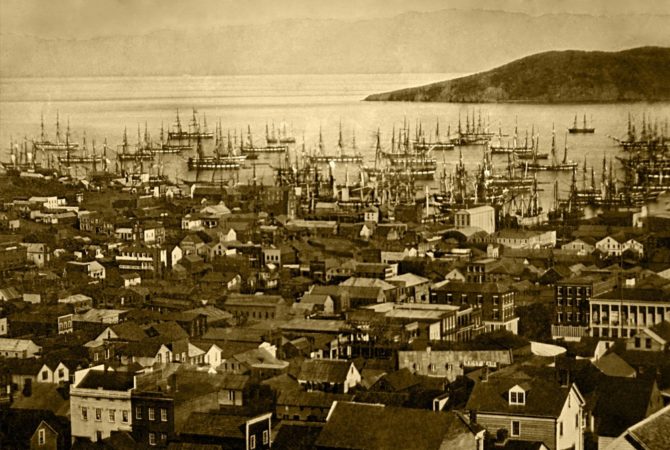Paris of the Pacific: Celebrating San Francisco’s Founding French Community
To highlight its reemergence after a devastating earthquake and fire, San Francisco was chosen as the venue of the 1915 World’s Fair. This year is the centennial of that Panama-Pacific International Exposition (PPIE.) “Un Coin de France en Amerique” (A Corner of France in America) is an exhibit of posters and artifacts at the city’s Alliance Française that highlights the French influence on that World’s Fair – and on San Francisco. It started with the Gold Rush of 1849.
“Did you know the French were the largest minority in San Francisco until the railroads brought over Chinese workers?” asked Anthony Morin, Cultural Events Coordinator for Alliance Française of San Francisco. “They came over for the Gold Rush, but got rich from providing the tools to mine gold.”
The French also invested in companies that organised the departure of French citizens to San Francisco. The arrangement was for the prospectors to bring the gold back to France, but that rarely happened. Instead, the French immigrants invested their lives, fortune and expertise in the city itself, creating a “Frenchtown” that influenced shops, businesses, food, saloons and culture. One of San Francisco’s nicknames was the “Paris of the Pacific.”
Referring to Dupont Street (now Grant Street) and Long Wharf, a San Francisco newspaper in June 1851 described Dupont: “The street is French, decidedly French, and in it you may see a miniature of the great city of ‘La Grande Republic.’”
The French were very involved in the Panama-Pacific International Exposition. (It also celebrated the opening of the Panama Canal, thus the name reference.) A French architect was on the Architectural Advisory Committee, and a French artist was on the International Jury of Awards. The French Pavilion was designed after Paris’s Legion of Honor, and Louis XVI-style of architecture influenced many of the PPIE buildings. Franco-Californians also won several of the Exposition’s awards, including the Larraburu Brothers for their “sour French bread,” now Boudin Bakery.
The posters and artifacts tell stories of French immigrant’s contributions to San Francisco up to the present. It is curated by Dr. Claudine Chalmers and sponsored by the French Mutual Benevolent Society. Dr. Chalmers has written French San Francisco, a book that relates France’s influence on San Francisco.
“French pioneers made San Francisco French from the inside,” said Dr. Chalmers.“This influence is still very strong despite the many cultural layers of subsequent immigrants from countries all over the world. Our present French associations and their strong leadership are bringing about a revival of this French heritage.”
The posters tell big and small stories, like the French artwork that was stored in the city to keep it safe from World War I. They illustrate French-style architecture from the department store Ville de Paris (currently Neimen-Marcus) with a sailing ship similar to Paris’ city symbol in its glass dome, to the Beaux-Arts White Building that now houses Banana Republic. The posters about food include bread and chocolate. Guittard & Co. Chocolate is the oldest continuously family-owned chocolate company in the United States, and See’s Candy uses Guittard chocolate. Emigrants from South-Western France began washing San Franciscans’ clothes by hand in the traditional French way until the term “French Laundry” became synonymous with quality.
According to Dr. Chalmers, the Frenchman who succeeded best in San Francisco arrived from Chile with a cargo of flour at a time when it was rare. Two weeks later, flour invaded the market and the price plummeted. But in those deux semaines he made a fortune. He invested his profits in The Polka, a gambling house, and returned to France a millionaire.
The French Hospital became the nation’s first HMO when Etienne Derbec started it in 1851. It became the West Coast’s best-equipped hospital with excellent doctors and surgeons, and was a training school for nurses. It boasted fireproof design, excellent cuisine, and modern bath facilities at only $2 per day for a ward bed, and $3.50 per day for a private room.
The exhibit artifacts are charming. They include the Official Guide to the Exhibition, playing cards with drawings of San Francisco’s French-styled buildings, the French Hospital patient sign-in book listing occupations such as sailor and barkeeper. There are souvenirs such as postcards, ashtrays, matchbooks, wine openers (bien sûr!) and a menu for the Poodle Dog Restaurant.
After the 1915 Exhibition, Alma de Bretteville Spreckels, of sugar fame, constructed a museum in the likeness of the French Pavilion, which is today’s California Palace of the Legion of Honor. Rodin’s “The Thinker” sits in the museum’s Court of Honor and greets visitors.
“The poster about Spreckels is my favorite,” said Morin. “She had a French background but was born and raised in the U.S., and had a big dream of helping this city get cultured. She was grateful for where she was and what she had, so she worked to create jobs and build a city with a future. She gave so much to San Francisco and lives changed because of her.”
The AFSF exhibit celebrates the French community that became an important part of San Francisco’s history and today’s culture.
“A Corner of France in America” runs until November 15, 2015 at the Alliance Française de San Francisco, located at 1345 Bush Street, San Francisco, CA 94109. It is part of the Panama-Pacific International Exposition Centennial.
Martha Sessums is the France Today Ambassador for San Francisco.
Share to: Facebook Twitter LinkedIn Email
Leave a reply
Your email address will not be published. Required fields are marked *






REPLY
REPLY